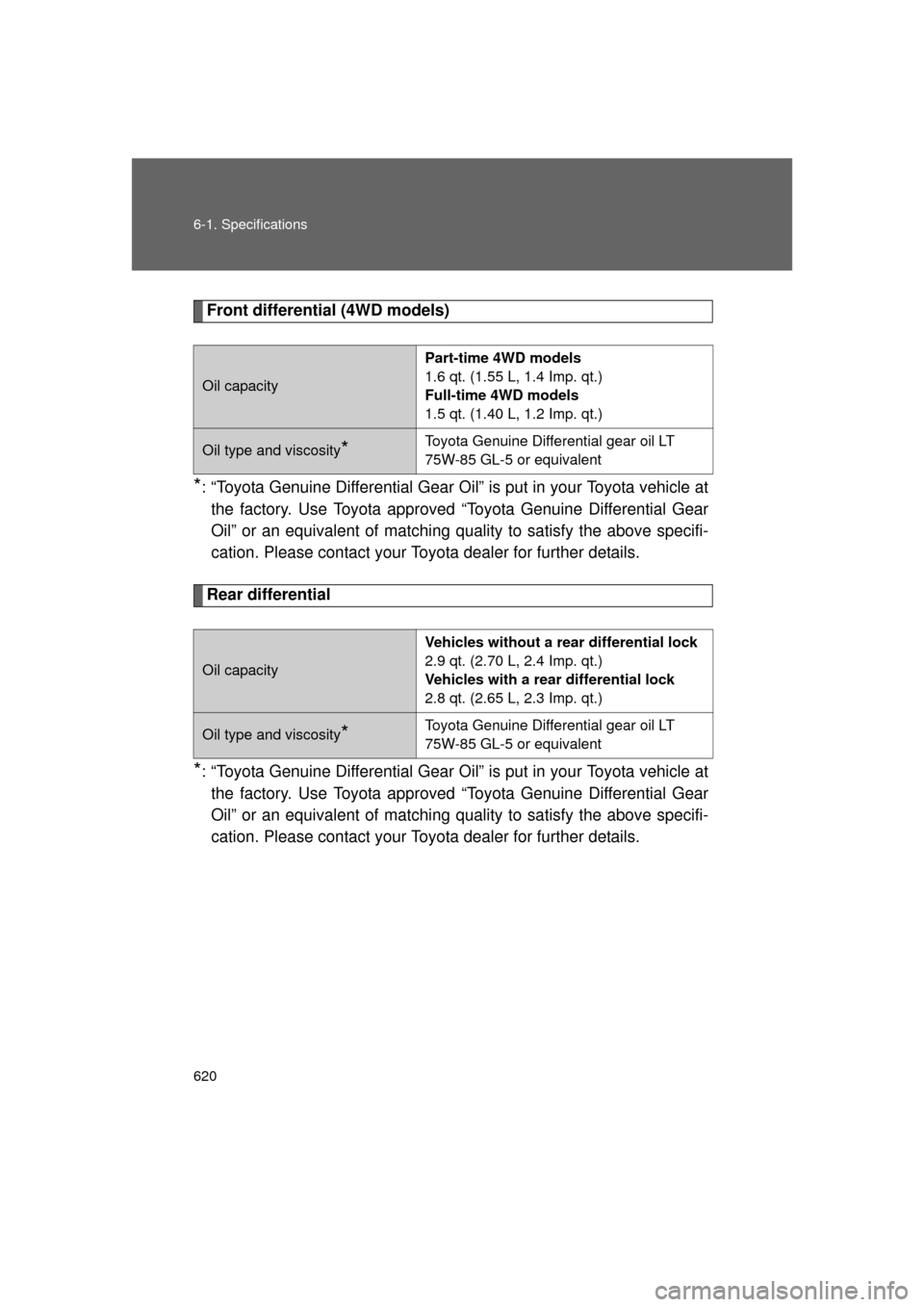Page 253 of 680

253
2-4. Using other driving systems
2
When driving
4RUNNER_U
Driving assist systems
To help enhance driving safety and performance, the following sys-
tems operate automatically in res ponse to various driving situations.
Be aware, however, that these systems are supplementary and
should not be relied upon too h eavily when operating the vehicle.
■ABS (Anti-lock Brake System)
Helps to prevent wheel lock when the brakes are applied suddenly, or if
the brakes are applied while driving on a slippery road surface
■Multi Terrain ABS (Anti-lock Brake System) (if equipped)
Helps to prevent wheel lock when the brakes are applied suddenly, or if
the brakes are applied while driving on a slippery road surface, or in off-
road conditions (such as rough roads, sand and mud)
The Multi Terrain ABS operates in syn chronization with the Multi-terrain
Select.
■ Brake assist
Generates an increased level of braking force after the brake pedal is
depressed when the system detects a panic stop situation
■VSC (Vehicle Stability Control)
Helps the driver to control skidding when swerving suddenly or turning
on slippery road surfaces
■TRAC/TRC (Traction Control)
Helps to maintain drive power and prevent the drive wheels from spin-
ning when starting the vehicle or accelerating on slippery roads
■Hill-start assist control (if equipped)
Helps to prevent the vehicle from rolling backward when starting on an
incline or slippery slope
■LSD (Limited Slip Differential) (if equipped)
Transfers drive power to the rear tires when front tires spin, and vice
versa, in order to improve traction
Page 259 of 680

259
2-4. Using other
driving systems
2
When driving
4RUNNER_U
■Hill-start assist control operation conditions
● The shift lever is in D or S.
● The brake pedal is not depressed.
● The rear differential is unlocked (if equipped).
■ If the brake system overheats
The hill-start assist control will cease operation and a buzzer will sound to
alert the driver. At this time, the “TRAC OFF (TRC OFF)” indicator will come
on. Stop the vehicle in a safe place. (There is no problem with continuing
with normal driving.)
The system will be automatically restored after a short time.
■ Sounds and vibrations caused by the ABS, Multi Terrain ABS (if
equipped), brake assist, VSC, TRAC (TRC) and hill-start assist control
(if equipped) systems
● A sound may be heard from the engine compartment when the engine is
started or just after the vehicle begins to move. This sound does not indi-
cate that a malfunction has occurred in any of these systems.
● Any of the following conditions may occur when the above systems are
operating. None of these indicates that a malfunction has occurred.
• Vibrations may be felt through the vehicle body and steering.
• A motor sound may be heard after the vehicle comes to a stop.
• The brake pedal may pulsate slightly after the ABS or Multi Terrain
ABS is activated.
• The brake pedal may move down slightly after the ABS or Multi Terrain ABS is activated.
■ Reactivation of the TRAC (TRC)/VSC systems after turning off the
engine
Turning off the engine after turning off the TRAC (TRC)/VSC systems will
automatically reactivate them.
■ Reactivation of the VSC system linked to vehicle speed (2WD models)
When the TRAC system is turned off and the AUTO LSD system is turned
on, the VSC system will turn on when vehicle speed increases. However,
when the TRAC and VSC systems are turned off, the systems will not turn
on even when vehicle speed increases.
Page 266 of 680

266 2-5. Driving information
4RUNNER_U
NOTICE
■To prevent water damage
Take all necessary safety measures to ensure that water damage to the
engine or other components does not occur.
● Water entering the engine air intake will cause severe engine damage.
● Water entering the automatic transmission will cause deterioration in shift
quality, locking up of your transmission accompanied by vibration, and ulti-
mately damage.
● Water can wash the grease from wheel bearings, causing rusting and pre-
mature failure, and may also enter the differentials, transmission and
transfer case, reducing the gear oil’s lubricating qualities.
■ When you drive through water
If driving through water, such as when crossing shallow streams, first check
the depth of the water and the bottom of the riverbed for firmness. Drive
slowly and avoid deep water.
■ Inspection after off-road driving
● Sand and mud that has accumulate d in brake drums and around brake
discs may affect braking efficiency and may damage brake system compo-
nents.
● Always perform a maintenance inspection after each day of off-road driv-
ing that has taken you through rough terrain, sand, mud, or water. For
scheduled maintenance information, refer to the “Scheduled Maintenance
Guide” or “Owner’s Manual Supplement”.
Page 289 of 680

289
2-5. Driving information
2
When driving
4RUNNER_U
■
Service connector for towing brake controller
■ Before towing
Check that the following conditions are met:
● The vehicle’s tires are properly inflated.
● Trailer tires are inflated according to the trailer manufacturer’s recom-
mendation.
● All trailer lights work.
● All lights work each time you connect them.
● The trailer ball is set up at the proper height for the coupler on the t\
railer.
● The vehicle remains level when a loaded or unloaded trailer is hitched.
Do not drive if the vehicle is not level, and check for improper tongue
load, overloading, worn suspension, or other possible causes.
● The trailer cargo is securely loaded.
● The rear view mirrors conform to all applicable federal, state/provincial or
local regulations. If they do not, install rear view mirrors appropriate for
towing purposes.
■ Break-in schedule
If your vehicle is new or equipped with any new power train components
(such as an engine, transmission, differential and wheel bearing), Toyota
recommends that you do not tow a trailer until it has been driven for over 500
miles (800 km).
However, avoid full throttle acceleration.
Your vehicle is equipped with a service
connector for the trailer brake controller
as shown.
CTH25AS008
Page 558 of 680
558 5-1. Essential information
4RUNNER_U
Using a flatbed truckIf you use chains or cables to tie
down your vehicle, the angles
shaded in black must be 45.
Do not overly tighten the tie
downs or the vehicle may be
damaged.
■ Before emergency towing
Vehicles without a smart key system: Turn the engine switch to the
“ACC” (engine off) or “ON” position.
Vehicles with a smart key system: Turn the “ENGINE START STOP” switch to ACCESSORY (engine off) or IGNITION ON mode
(engine running).
Part-time 4WD models: Shift the front-wheel drive control lever to
H2.
Full-time 4WD models: Put the four-wheel drive control switch in
H4F. (The center differential is unlocked.)
Shift the shift lever to N.
Release the parking brake.
STEP 1
STEP 2
STEP 3
STEP 4
Page 620 of 680

620 6-1. Specifications
4RUNNER_U
Front differential (4WD models)
*: “Toyota Genuine Differential Gear Oil” is put in your Toyota vehicle atthe factory. Use Toyota approved “Toyota Genuine Differential Gear
Oil” or an equivalent of matchi ng quality to satisfy the above specifi-
cation. Please contact your Toyo ta dealer for further details.
Rear differential
*: “Toyota Genuine Differential Gear Oil” is put in your Toyota vehicle at
the factory. Use Toyota approved “Toyota Genuine Differential Gear
Oil” or an equivalent of matchi ng quality to satisfy the above specifi-
cation. Please contact your Toyo ta dealer for further details.
Oil capacity
Part-time 4WD models
1.6 qt. (1.55 L, 1.4 Imp. qt.)
Full-time 4WD models
1.5 qt. (1.40 L, 1.2 Imp. qt.)
Oil type and viscosity*Toyota Genuine Differential gear oil LT
75W-85 GL-5 or equivalent
Oil capacity
Vehicles without a rear differential lock
2.9 qt. (2.70 L, 2.4 Imp. qt.)
Vehicles with a rear differential lock
2.8 qt. (2.65 L, 2.3 Imp. qt.)
Oil type and viscosity*Toyota Genuine Differential gear oil LT
75W-85 GL-5 or equivalent
Page 664 of 680
664
4RUNNER_U
Abbreviation list
Abbreviation/Acronym list
ABBREVIATIONSMEANING
2WD 2 Wheel Drive
4WD 4 Wheel Drive
ABS Anti-lock Brake System
ACC Accessory
AI-SHIFT Artificial Intelligence Shift control
ALR Automatic Locking Retractor
A-TRAC Active traction control system
AUTO LSD Automatic Limited Slip Differential
AUX Auxiliary
CRS Child Restraint System
DAC Downhill assist control system
ECU Electronic Control Unit
EDR Event Data Recorder
ELR Emergency Locking Retractor
GAWR Gross Axle Weight Rating
GCWR Gross Combination Weight Rating
GVWR Gross Vehicle Weight Rating
I/M Emission Inspection and Maintenance
KDSS Kinetic Dynamic Suspension System
LATCH Lower Anchors and Tethers for Children
LED Light Emitting Diode
LSD Limited Slip Differential
MAX Maximum
MIN Minimum
MMT Methylcy clopentadienyl Manganese Tricarbonyl
M+S Mud and Snow
MTBE Methyl Tertiary Butyl Ether
Page 667 of 680

667
Alphabetical index
4RUNNER_U
Back door
Back door ............................... 56
Back window .......................... 94
Smart key system ... ................ 33
Wireless remote control.......... 47
Back-up lights
Replacing light bulbs ............ 542
Wattage ................................ 624
Back window ............................. 94
Battery
Checking .............................. 509
If the vehicle has a discharged battery ............ 599
Preparing and checking before winter ...................... 275
Bluetooth
® audio..................... 364
Bluetooth® phone ................... 380
Bottle holder ............................ 427
Brake
Fluid...................................... 505
Parking brake ....................... 180
Brake assist ............................. 253
Break-in tips ............................ 155
Brightness control Instrument light control ......... 187 Care
Exterior ..................................478
Interior ...................................481
Seat belts ..............................482
Cargo capacity .........................267
Cargo hooks .............................456
Cargo net hooks.......................457
CD player/changer ...................324
Center differential lock ............226
Chains .......................................277
Child-protectors .........................53
Child restraint system Booster seats, definition ........136
Booster seats, installation .....140
Convertible seats, definition .............................136
Convertible seats, installation ...........................140
Front passenger occupant classification system ...........130
Infant seats, definition ...........136
Infant seats, installation.........140
Installing CRS with LATCH system........ ............142
Installing CRS with
seat belts ............................145
Installing CRS with top straps ..................................148
BC